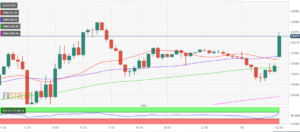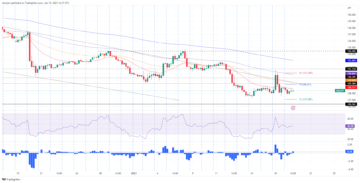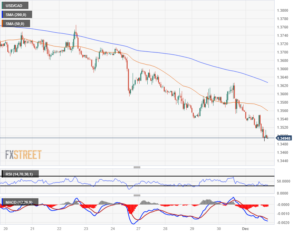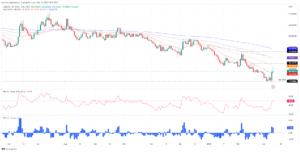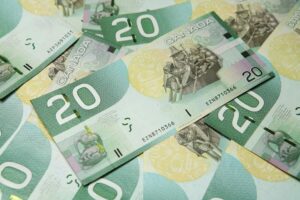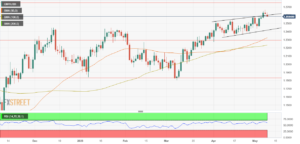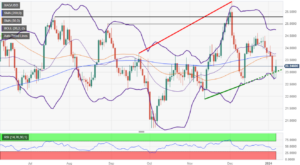- Australian Dollar maintains bullish sentiment on dovish Fed outlook.
- Australia’s Manufacturing and Services PMI increased to 47.8 and 47.6, respectively.
- PBoC maintained its Medium-term Lending Facility rate (MLF) at 2.5%.
- China’s Industrial Production and Retail Sales improved to 6.6% and 10.1%, respectively, in November.
- US Retail Sales rose 0.3% and Initial Jobless Claims reduced to 202K.
The Australian Dollar (AUD) continues its winning streak for the third consecutive day on Friday. The AUD/USD pair receives upward support from improving Australia’s Purchasing Managers Index (PMI) data for December, released by Judo Bank and S&P Global. Additionally, China’s improved data contributes support to reinforcing the strength of the Australian Dollar.
Australia’s economy displays resilience, bolstered by robust employment results and expanding incomes. The preliminary Judo Bank Composite PMI has shown improvement, rising to 47.4 from the previous reading of 46.2. The Manufacturing PMI for the same period registered 47.8, a slight increase from the prior figure of 47.7. Additionally, the Services PMI grew to 47.6 compared to the previous reading of 46.0.
The People’s Bank of China (PBoC) kept its 1-year Medium-term Lending Facility (MLF) rate unchanged at 2.5%, the interest rate on MLF loans is a key factor influencing liquidity conditions in the banking system. Additionally, 650 billion Yuan worth of MLF loans are set to mature, and the central bank injects 1.45 trillion Yuan, a greater amount to bolster bank liquidity. These actions by the PBoC support the financial system and enhance economic conditions in China. Given Australia’s status as a major exporter to China, improvements in China’s economic conditions often translate to increased demand for Australian exports, contributing to the strength of the Aussie Dollar.
The National Bureau of Statistics of China revealed that Industrial Production (YoY) improved to 6.6% in November from 4.6% prior, exceeding the market expectation of 5.6%. However, China Retail Sales (YoY) rose to 10.1% from 7.6% prior, falling short of the market consensus of a 12.5% rise.
The US Dollar Index (DXY) attempts to rebound from a four-month low at 101.77 marked on Thursday. The DXY extends the negative momentum that followed the Federal Open Market Committee (FOMC) statement. Better-than-expected economic data from the United States (US) provided only modest support for the US Dollar (USD).
US Retail Sales (MoM) rose 0.3% in November, compared to the expected decline of 0.1%. Initial Jobless Claims for the week ending on December 8 came in at 202K against the 220K expected.
The dovish signals from the US Federal Reserve (Fed) have put pressure on the USD, especially as Treasury yields dropped to multi-month lows. The Fed’s cautious outlook on interest rates and the potential for a more accommodative monetary policy stance in 2024 contribute to the ongoing weakness in the Greenback.
Daily Digest Market Movers: Australian Dollar soars on dovish Fed’s outlook
- Australia’s Consumer Inflation Expectations for December eased at 4.5% against the previous figures of 4.9%.
- The seasonally adjusted Employment Change (Nov) improved substantially to 61.5K compared to the expected 11.0K. Unemployment Rate rose to 3.9% from 3.7% previously.
- ANZ-Roy Morgan Australian Consumer Confidence weekly survey rose to 80.8 from the previous week’s 76.4.
- Westpac Consumer Confidence for December showed improvement at 2.7% from the previous decline of 2.6%.
- Australian government anticipates a significantly improved budget bottom line this year as revenues outpace forecasts. In the mid-year economic and fiscal outlook (MYEFO) presented by Labor Treasurer Jim Chalmers, a budget deficit of just AUD 1.1 billion (USD 721.4 million) in the year to end June 2024 is projected, down from the AUD 13.9 billion forecast back in May.
- Federal Reserve (Fed) maintained interest rates at 5.5% in its December policy meeting as expected. Markets are now projecting three rate cuts for 2024.
- US Bureau of Labor Statistics revealed that the PPI (YoY) reduced to the growth of 0.9% against the expected growth of 1.0%, while the Core PPI came in at 2.0% against the 2.2% expected.
- US Bureau of Labor Statistics revealed that the US Consumer Price Index (CPI) for November rose by 0.1% month-on-month and 3.1% year-on-year. Both figures aligned with market consensus, indicating that inflation levels met expectations.
- US Core CPI, which excludes volatile food and energy prices, climbed by 0.3% MoM and 4.0% YoY, in line with expectations.
Technical Analysis: Australian Dollar edges above the 0.6700 psychological level
The Australian Dollar hovers around 0.6720 on Friday near its five-month high at 0.6728 recorded in the previous session. A bullish sentiment could drive the AUD/USD pair to revisit the recent high, followed by the significant barrier at 0.6750. On the downside, the key support at 0.6650 is of significance followed by the 23.6% Fibonacci retracement at 0.6619, before reaching the psychological support at 0.6600. A decisive breach below this support level might exert downward pressure on the AUD/USD pair to test the 21-day Exponential Moving Average (EMA) at 0.6588.
AUD/USD: Daily Chart
Australian Dollar price today
The table below shows the percentage change of Australian Dollar (AUD) against listed major currencies today. Australian Dollar was the strongest against the Pound Sterling.
| USD | EUR | GBP | CAD | AUD | JPY | NZD | CHF | |
| USD | -0.05% | 0.02% | -0.15% | -0.26% | -0.37% | -0.09% | -0.21% | |
| EUR | 0.03% | 0.05% | -0.09% | -0.23% | -0.29% | -0.08% | -0.15% | |
| GBP | -0.01% | -0.05% | -0.14% | -0.28% | -0.35% | -0.13% | -0.21% | |
| CAD | 0.14% | 0.09% | 0.15% | -0.13% | -0.21% | 0.01% | -0.07% | |
| AUD | 0.26% | 0.23% | 0.28% | 0.13% | -0.08% | 0.14% | 0.07% | |
| JPY | 0.37% | 0.30% | 0.36% | 0.20% | 0.08% | 0.22% | 0.14% | |
| NZD | 0.13% | 0.05% | 0.10% | -0.05% | -0.17% | -0.28% | -0.09% | |
| CHF | 0.20% | 0.15% | 0.21% | 0.06% | -0.07% | -0.09% | 0.10% |
The heat map shows percentage changes of major currencies against each other. The base currency is picked from the left column, while the quote currency is picked from the top row. For example, if you pick the Euro from the left column and move along the horizontal line to the Japanese Yen, the percentage change displayed in the box will represent EUR (base)/JPY (quote).
Interest rates FAQs
Interest rates are charged by financial institutions on loans to borrowers and are paid as interest to savers and depositors. They are influenced by base lending rates, which are set by central banks in response to changes in the economy. Central banks normally have a mandate to ensure price stability, which in most cases means targeting a core inflation rate of around 2%.
If inflation falls below target the central bank may cut base lending rates, with a view to stimulating lending and boosting the economy. If inflation rises substantially above 2% it normally results in the central bank raising base lending rates in an attempt to lower inflation.
Higher interest rates generally help strengthen a country’s currency as they make it a more attractive place for global investors to park their money.
Higher interest rates overall weigh on the price of Gold because they increase the opportunity cost of holding Gold instead of investing in an interest-bearing asset or placing cash in the bank.
If interest rates are high that usually pushes up the price of the US Dollar (USD), and since Gold is priced in Dollars, this has the effect of lowering the price of Gold.
The Fed funds rate is the overnight rate at which US banks lend to each other. It is the oft-quoted headline rate set by the Federal Reserve at its FOMC meetings. It is set as a range, for example 4.75%-5.00%, though the upper limit (in that case 5.00%) is the quoted figure.
Market expectations for future Fed funds rate are tracked by the CME FedWatch tool, which shapes how many financial markets behave in anticipation of future Federal Reserve monetary policy decisions.
- SEO Powered Content & PR Distribution. Get Amplified Today.
- PlatoData.Network Vertical Generative Ai. Empower Yourself. Access Here.
- PlatoAiStream. Web3 Intelligence. Knowledge Amplified. Access Here.
- PlatoESG. Carbon, CleanTech, Energy, Environment, Solar, Waste Management. Access Here.
- PlatoHealth. Biotech and Clinical Trials Intelligence. Access Here.
- Source: https://www.fxstreet.com/news/australian-dollar-hovers-near-a-psychological-level-after-retreating-from-five-month-high-202312150151
- :has
- :is
- ][p
- $UP
- 1
- 10
- 11
- 12
- 13
- 2%
- 2024
- 220K
- 23
- 28
- 32
- 33
- 41
- 46
- 7
- 77
- 8
- 80
- 9
- a
- above
- actions
- Additionally
- Adjusted
- After
- against
- aligned
- along
- amount
- an
- analysis
- and
- Animate
- anticipates
- anticipation
- ARE
- around
- AS
- asset
- At
- attempt
- Attempts
- attractive
- AUD
- AUD/USD
- aussie
- Australia
- Australian
- Australian dollar
- average
- back
- Bank
- bank liquidity
- Bank of China
- Banking
- banking system
- Banks
- barrier
- base
- because
- before
- below
- Billion
- bolster
- boosting
- borrowers
- both
- Bottom
- Box
- breach
- budget
- Bullish
- Bureau
- bureau of labor statistics
- by
- came
- case
- cases
- Cash
- cautious
- central
- Central Bank
- Central Banks
- change
- Changes
- charged
- China
- china retail sales
- chinese
- claims
- Climbed
- CME
- Column
- committee
- compared
- conditions
- confidence
- consecutive
- Consensus
- consumer
- consumer price index
- content
- continues
- contribute
- contributing
- Core
- core inflation
- Cost
- could
- country’s
- CPI
- currencies
- Currency
- Cut
- cuts
- daily
- data
- day
- December
- decisions
- decisive
- Decline
- DEFICIT
- Demand
- depositors
- Digest
- displayed
- displays
- Dollar
- dollars
- Dovish
- down
- downside
- downward
- drive
- dropped
- Dxy
- each
- Economic
- Economic Conditions
- economy
- effect
- EMA
- employment
- end
- ending
- ends
- energy
- energy prices
- enhance
- ensure
- especially
- EUR
- Euro
- example
- expanded
- expanding
- expectation
- expectations
- expected
- exponential
- exponential moving average
- exports
- extends
- Facility
- factor
- Falling
- falling short
- Falls
- FAQ
- Fed
- fed funds rate
- Federal
- Federal Open Market Committee
- federal reserve
- Figure
- Figures
- financial
- Financial institutions
- financial system
- Fiscal
- five
- followed
- FOMC
- food
- For
- forecasts
- Friday
- from
- funds
- future
- generally
- given
- Global
- Gold
- Government
- greater
- Greenback
- grew
- Growth
- Have
- headline
- help
- High
- Highs
- holding
- Horizontal
- How
- However
- HTTPS
- if
- improved
- improvement
- improvements
- improving
- in
- Increase
- increased
- index
- indicating
- industrial
- Industrial Production
- inflation
- Inflation expectations
- inflation rate
- influenced
- influencing
- initial
- instead
- institutions
- interest
- INTEREST RATE
- Interest Rates
- investing
- Investors
- IT
- ITS
- Japanese
- Japanese Yen
- Jim
- Jim Chalmers
- jobless claims
- june
- just
- kept
- Key
- key factor
- labor
- left
- LEND
- lending
- Level
- levels
- LIMIT
- Line
- Liquidity
- Listed
- Loans
- Low
- lower
- lowering
- Lows
- maintains
- major
- make
- Managers
- mandate
- manufacturing
- many
- map
- marked
- Market
- Markets
- mature
- May..
- means
- meeting
- meetings
- met
- might
- million
- MLF
- modest
- module
- mom
- Momentum
- Monetary
- Monetary Policy
- money
- Month
- more
- Morgan
- most
- move
- Movers
- moving
- moving average
- National
- Near
- negative
- normally
- nov
- November
- now
- of
- often
- on
- ongoing
- only
- open
- Opportunity
- or
- Other
- Outlook
- overall
- overnight
- paid
- pair
- Park
- PBOC
- People
- People's Bank of China (PBoC)
- percentage
- period
- pick
- picked
- Place
- placing
- plato
- Plato Data Intelligence
- PlatoData
- pmi
- policy
- potential
- pound
- pound sterling
- ppi
- preliminary
- presented
- pressure
- previous
- previously
- price
- Prices
- Prior
- Production
- projected
- provided
- psychological
- purchasing
- pushes
- put
- quote
- raising
- range
- Rate
- Rates
- reaching
- Reading
- rebound
- receives
- recent
- recorded
- Reduced
- registered
- released
- represent
- Reserve
- resilience
- respectively
- response
- Results
- retail
- Retail Sales
- retracement
- Revealed
- revenues
- Rise
- Rises
- rising
- robust
- ROSE
- ROW
- s
- S&P
- S&P Global
- sales
- same
- Savers
- sentiment
- Services
- session
- set
- shapes
- Short
- showed
- shown
- Shows
- signals
- significance
- significant
- significantly
- since
- Soars
- Stability
- stance
- starts
- Statement
- States
- statistics
- Status
- sterling
- strength
- Strengthen
- strongest
- substantially
- support
- support level
- Survey
- system
- table
- Target
- targeting
- test
- that
- The
- the Fed
- The US Federal Reserve
- their
- These
- they
- Third
- this
- this year
- though?
- three
- thursday
- to
- today
- tool
- top
- translate
- Treasurer
- treasury
- Treasury yields
- Trillion
- unemployment
- unemployment rate
- United
- United States
- upward
- us
- US banks
- US Dollar
- US Federal
- us federal reserve
- USD
- usually
- View
- volatile
- was
- weakness
- week
- weekly
- weigh
- which
- while
- will
- winning
- with
- worth
- year
- Yen
- yields
- you
- Yuan
- zephyrnet

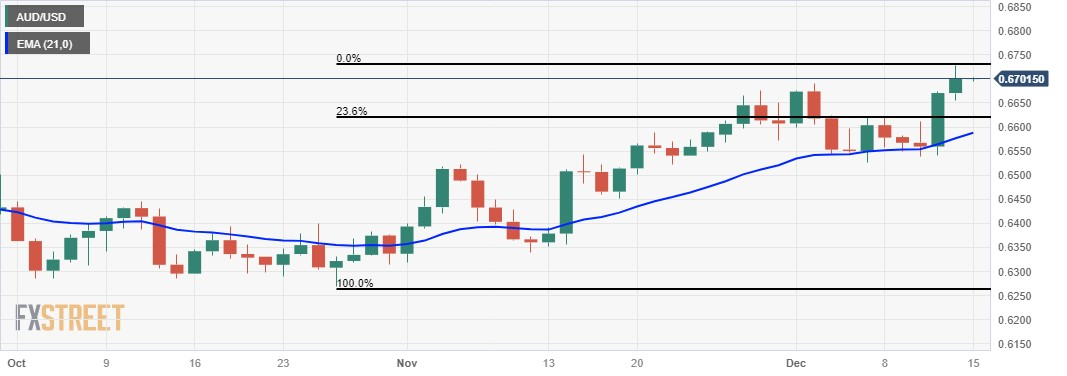

![Elliott Wave analysis: Insights & strategies [Video]](https://platoaistream.com/wp-content/uploads/2023/10/elliott-wave-analysis-insights-strategies-video-300x200.jpg)
